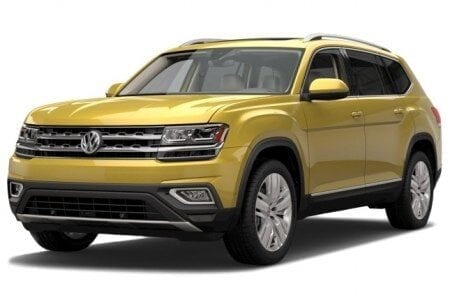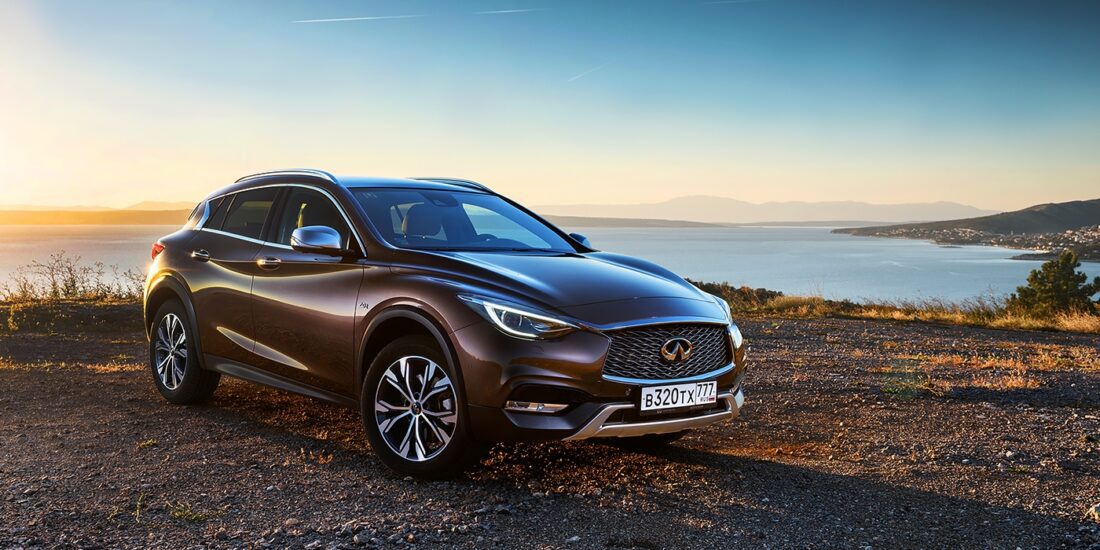
Test drive Infiniti QX30
A compact Infiniti with high ground clearance, built on a Mercedes chassis, looks tempting, apart from the price. The QX30 stands as the older Q50 - also all-wheel drive. However, these models cannot be directly compared
Stir but do not shake. Or not mix, but just share the components. The recipe is simple, well-known and not at all shameful, even when it comes to premium models. The client, after all, does not care at all that the junior models of Inifiniti are based on a Mercedes chassis. The only question is how original these machines turn out to be. Judging by the Q30 hatchback, they are not only original, but also with a twist. The fishy style of Inifiniti in this model finally played for real - the product turned out to be bright, stylish and completely unlike anything else.
The idea to make Infiniti from Mercedes-Benz was born five years ago, when the Japanese were seriously targeting the European and Chinese markets. The premium segment, they are sure of the company, is growing rapidly precisely due to wealthy young consumers, who by the end of this decade will account for at least 80%. They do not need large sedans, and they define the premium quality of the car primarily by design and functionality. Therefore, high-quality golf-class models were needed, and Infiniti did not have a platform suitable for the premium segment.
The solution was found in the framework of an alliance with Daimler. The Germans received units for smart, a ready-made "heel" based on Renault Kangoo and a Nissan pickup truck, which will soon turn into a serial X-Class, and the Japanese got a compact platform and turbo engines. And not only the platform - the Japanese logically used the salon and all the equipment that they managed to bargain for during the difficult negotiations, as representatives of the company never tire of repeating.
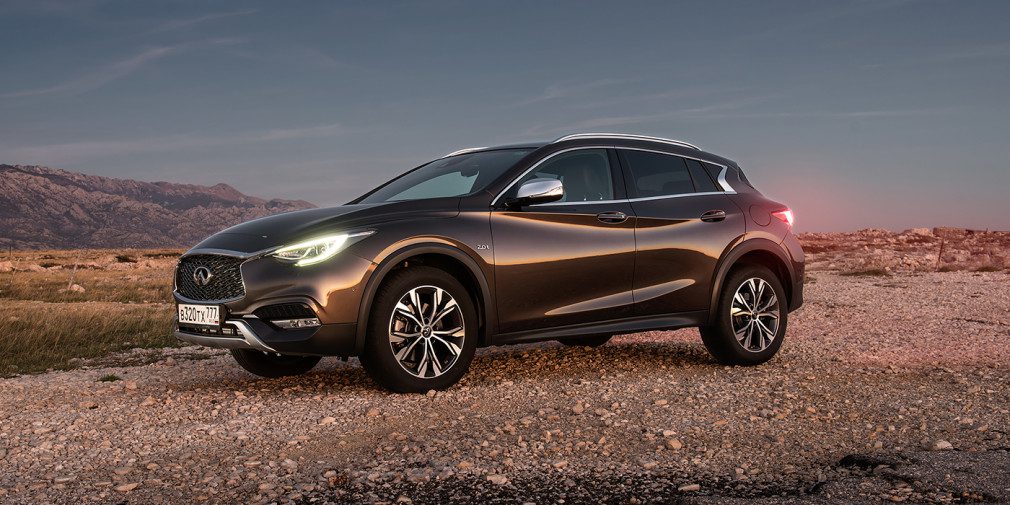
Still, the Q30 came out differently, and not only externally. In addition, the basis of the Japanese car was not the base A-class chassis, but the GLA units - in about the same way as the VAZ employees took not Sandero, but Sandero Stepway for XRAY. The difference within a single platform may not be great, but the Infiniti Q30 hatchback already looks uplifted and bold. And much more youthful compared to the classic appearance of a German donor. If you add to this look an even higher ground clearance, a plastic body kit and a few styling elements, then you get quite a real crossover. With the body kit, the QX30 was not too clever - there is enough plastic, it is in place and looks appropriate. The QX30 is even more expressive than the base Q30, and it is on it that the Russian representative office of the company is counting.
Interestingly, in the US, a pure Q30 is not sold, but the QX30 is there in several trim levels, which differ in the degree of crossover, that is, the amount of body kit and the amount of ground clearance - from low Sport to the conditionally off-road QX30 AWD. The ground clearance of the versions differs by a good 42 millimeters. The Russian version corresponds to the highest American version, which means a clearance of 202 mm - the largest in the segment among premium models. In Russia, the youngest of the Infiniti crossovers stands in full growth and exists only in the "top" version with all-wheel drive. Unlike the soplatform Mercedes-Benz GLA with its modest 154 mm (or 174 mm when ordering an "off-road" package), an initial 1,6-liter engine and front-wheel drive only.
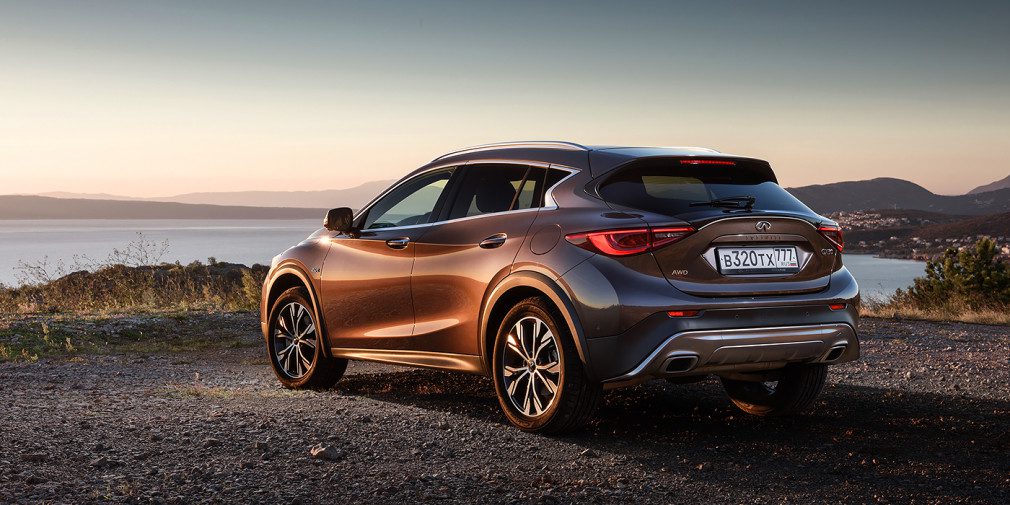
Probably, for the same reason, we do not have sports seats for the QX30 - only comfortable, slightly imposing electric chairs, the adjustment keys of which are located in the Mercedes-style on the doors. The shape and finish of the door panels are borrowed from the donor without changes, the steering wheel and instruments are from Mercedes. And here is the only dozen-function steering column lever that annoys Mercedes-Benz opponents. But there is no steering wheel "poker" transmission here - the box is controlled by a more traditional selector on the tunnel, which is borrowed from the AMG version of the A-class.
But here's what's interesting: The Infiniti's interior looks richer than elegant German - partly because of the taller panel, partly because of the abundance of soft, pleasant-smelling leather. The salon of any Infiniti evokes couch associations, and junior models are no exception. But varnished plastic under a tree is still too much. The Germans have not made such crude imitations for a long time. But the QX30 has a touchscreen display of the media system and a surround-view camera - technologies that Mercedes for some reason will not implement on all their models. The Japanese system does not offer sophisticated graphics and sometimes slows down, but this option is still more functional than the German one.
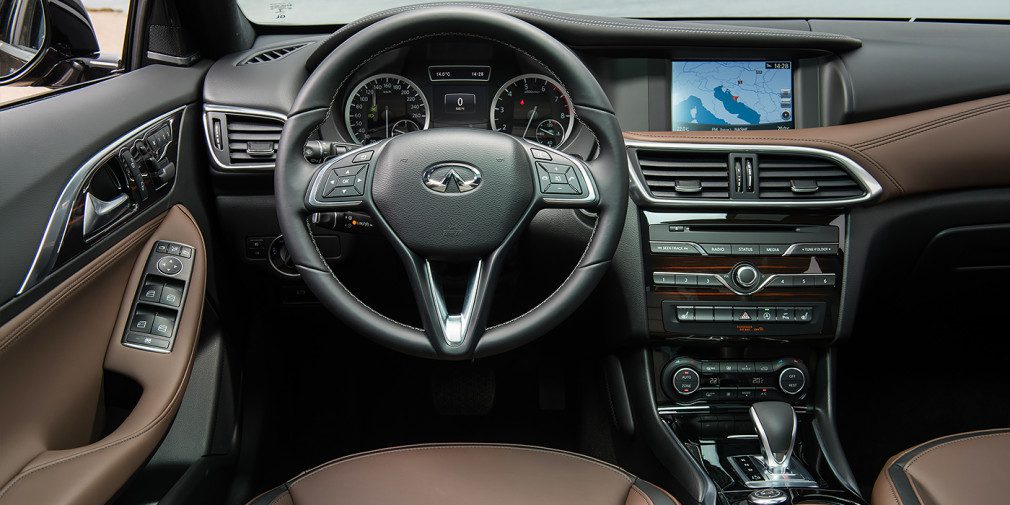
The tightness of the cabin is a feature of the base model, and there is certainly nothing you can do about it. The low ceiling forces the seat to be lowered all the way, and no commander's landing is possible here. At the back, two are quite normal, but the doorway is narrow and low - you can kiss your head or wipe the wheel arch with your trouser leg. The trunk is even more modest: 431 liters versus Mercedes' 480 liters. For a Golf-class hatchback, all this seems absolutely normal, but you still expect more variability from a crossover.
Beautiful 18-inch wheels for a golf-class car are perhaps overkill, although it is largely thanks to them that the car looks so fast. Looking at them, you expect furious rigidity of the chassis, but there is nothing like it. The suspension turned out to be just what you need - moderately dense, understandable and quite comfortable on a normal surface. Another thing is that the base is short, and on an uneven road the car shakes, not having time to work out all the flaws of the asphalt. The driver still likes it - both the unambiguous reactions and the tight steering wheel with adequate feedback. The Japanese recalibrated the electric amplifier in their own way, and it turned out quite universally without the ostentatious lightness and excessive elasticity, which is usually imitated by sportiness.
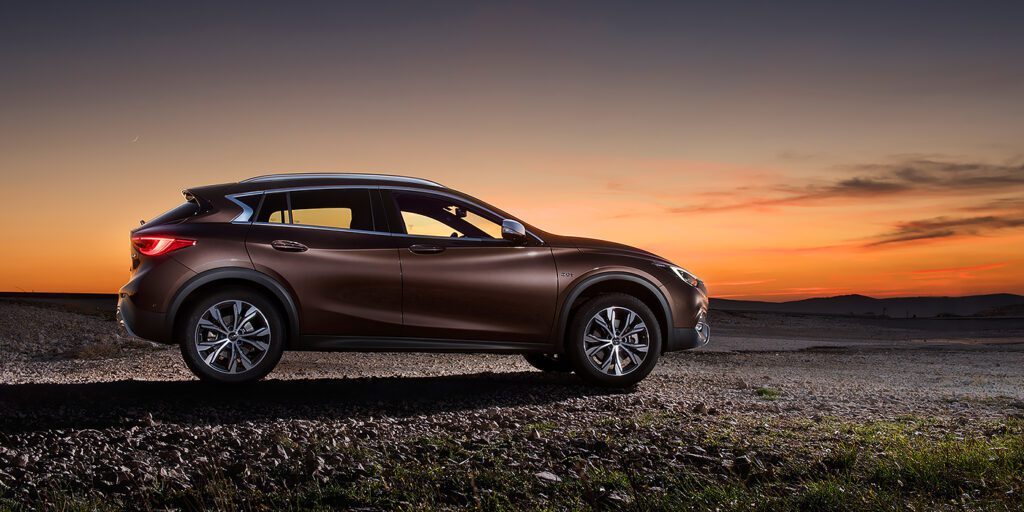
The Mercedes two-liter engine is good without reservations, it allows you to drive quickly and dynamically, confidently going overtaking. More seems to be not needed, but less - I do not want: a little more than 7 seconds to "hundreds" exactly correspond to the expectations of a youth compact. The sound of the engine is pleasantly bass, the operation of the preselective box is imperceptible, and the future buyer will hardly think about the functioning of the all-wheel drive transmission. Everything happens in automatic mode, and the car, obviously, will cope with some kind of city snowfall without difficulty. And high ground clearance is more protection against accidental touches with curbs than for overcoming real off-road.
Judging by the bare numbers of the price lists, the basic QX30 is more expensive than the soplatform Mercedes-Benz GLA in the maximum configuration. If that were the case, then there would be no point in bringing the Infiniti QX30 to a market that is passionate about German premium brands. The secret is that the Japanese offer initially rich fixed configurations, and the Germans - "Special series", the revision of which will significantly increase the price tag. LED headlights, leather upholstery, seven airbags, a Bose audio system and dual-zone climate control are already standard on the QX30. Although formally getting a cheaper GLA, like the Audi Q3, is quite possible, and the Volvo V40 Cross Country with its rich set of trim levels seems just affordable against this background.
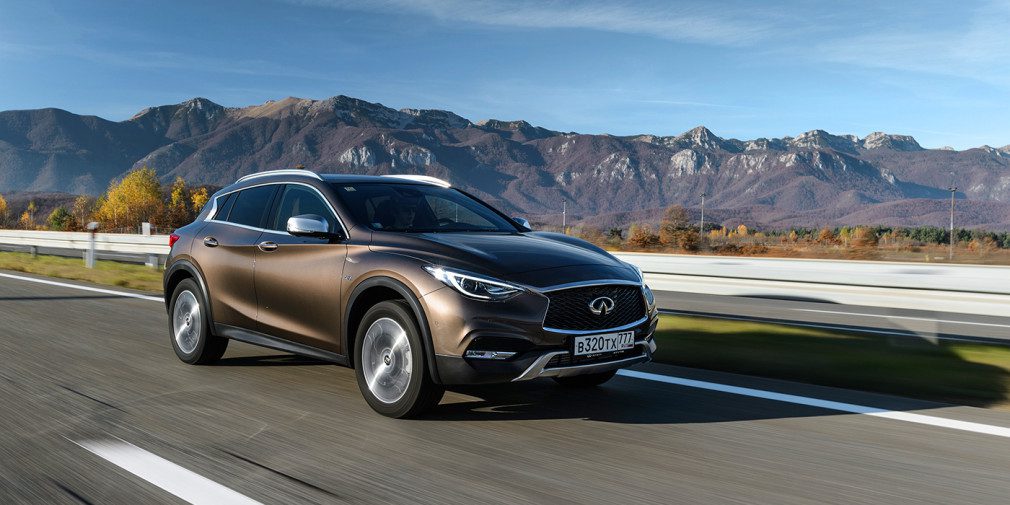
QX30 in Russia is offered in three trim levels, which differ for the most part in the trim elements and the presence of a circular view system. The top version of Cafe Teak with the most original combinations of leather and Alcantara in this sense is more Inifiniti than all the others. And exactly the same Mercedes in terms of ride quality and interior comfort. But visually and emotionally, any QX30, like the simpler Q30, is still different cars. And it is they who are able to solve a small paradox of that very youth audience with money: if a small Mercedes is seemingly not quite right, then in the same Infiniti there is nothing shameful, it seems.
| I | ||
| Body type | Hatchback | |
| Dimensions (length / width / height), mm | 4425 / 1815 / 1555 | |
| Wheelbase, mm | 2700 | |
| Curb weight, kg | 1542 | |
| engine's type | Gasoline, R4 | |
| Working volume, cubic meters cm. | 1991 | |
| Max. power, h.p. (at rpm) | 211 at 5500 | |
| Max. cool. moment, nm (at rpm) | 350 at 1200-4000 | |
| Drive type, transmission | Full, 7RKP | |
| Max. speed km / h | 230 | |
| Acceleration from 0 to 100 km / h, s | 7,3 | |
| Fuel consumption gor./trassa/mesh., L | 8,9 / 5,7 / 6,9 | |
| Cargo space | 430 | |
| Price from, $. | 35 803 |
Together with the QX30, the journalists were presented with the updated Infiniti Q50 sedan, the main innovation of which was a three-liter V6 biturbo engine with a return of 405 horsepower. The most powerful version of the Infiniti Q50 still cannot be put in a row of super-fast sedans like the Mercedes-AMG C63 or BMW M3, but this car rightfully falls a notch lower into the Audi S4, C43 AMG or BMW 340i segment.
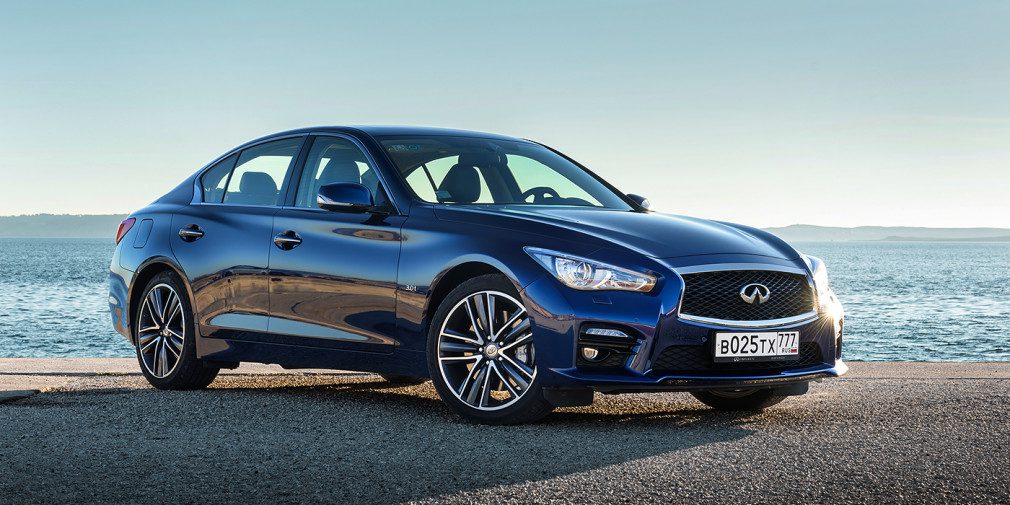
No slippage: the all-wheel-drive Q50 takes off momentarily, picking up speed almost linearly. The engine spins up to the maximum 7000 rpm, the seven-speed "automatic" instantly changes gears, and the sedan flies on without hesitation. "Six" voices softly, but harshly, slightly bubbling, like a voluminous V8. Acceleration is good even at speeds over 100 km / h, but the sedan exchanges the first "hundred" most effectively. According to the stated data, acceleration to 100 km / h takes 5,4 seconds, but it seems that in fact everything is happening even faster. Especially in Sport + mode, which was not on the pre-reform car.
The operating modes of the units are changed by a swinging lever on the central tunnel, and the choice has become larger - five programs from the lean "snow" to the extreme Sport +, and one more customizable. Another thing is that one should not expect serious changes in the character of the car from them. Even if you choose the quiet Eco, by pressing the accelerator the car can be brought back to life at high revs in a split second. Chassis settings don't change too noticeably. The electronically controlled dampers are still resilient anyway, but without fanaticism, offering a reasonable level of comfort for a car of this power. And there is no sense at all to influence the steering settings - in standard mode, the recoil fully meets expectations.
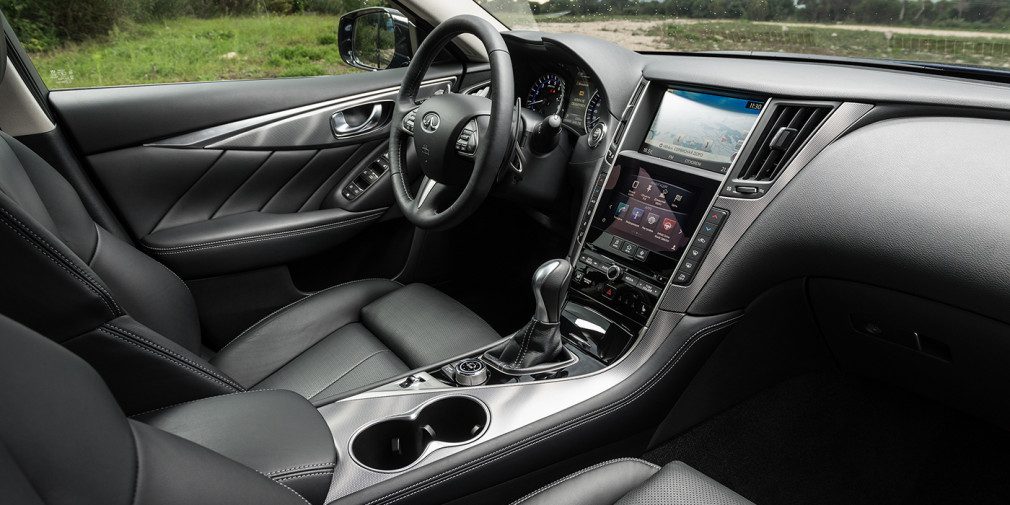
The highlight is that there is no mechanical connection between the steering wheel and the wheels. The powerful Q50 is controlled by wire, and nothing else, although it is impossible to guess that there is no usual steering shaft. In civilian driving modes, the recoil on the steering wheel is quite familiar - with a slight phlegmatism in the near-zero zone and a pleasant effort in turns stronger. And in the steepest bends, the steering wheel becomes more elastic and perfectly imitates the resistance of the wheels, although at this moment you only turn the air with your own hands.
The three-liter Inifniti Q50 is a case of excellent Value for money. All-wheel drive sedan with a capacity of 405 hp. fits into the $ 36-$ 721 price fork, and no competitor will offer the same low horsepower cost. Only the more affordable initial Q40 with a two-liter Mercedes turbo engine with 655 hp can hinder sales of the top version. and rear-wheel drive - simply because it's even more affordable.
No slippage: the all-wheel-drive Q50 takes off momentarily, picking up speed almost linearly. The engine spins up to the maximum 7000 rpm, the seven-speed "automatic" instantly changes gears, and the sedan flies on without hesitation. "Six" voices softly, but harshly, slightly bubbling, like a voluminous V8. Acceleration is good even at speeds over 100 km / h, but the sedan exchanges the first "hundred" most effectively. According to the stated data, acceleration to 100 km / h takes 5,4 seconds, but it seems that in fact everything is happening even faster. Especially in Sport + mode, which was not on the pre-reform car.
The operating modes of the units are changed by a swinging lever on the central tunnel, and the choice has become larger - five programs from the lean "snow" to the extreme Sport +, and one more customizable. Another thing is that one should not expect serious changes in the character of the car from them. Even if you choose the quiet Eco, by pressing the accelerator the car can be brought back to life at high revs in a split second. Chassis settings don't change too noticeably. The electronically controlled dampers are still resilient anyway, but without fanaticism, offering a reasonable level of comfort for a car of this power. And there is no sense at all to influence the steering settings - in standard mode, the recoil fully meets expectations.
The highlight is that there is no mechanical connection between the steering wheel and the wheels. The powerful Q50 is controlled by wire, and nothing else, although it is impossible to guess that there is no usual steering shaft. In civilian driving modes, the recoil on the steering wheel is quite familiar - with a slight phlegmatism in the near-zero zone and a pleasant effort in turns stronger. And in the steepest bends, the steering wheel becomes more elastic and perfectly imitates the resistance of the wheels, although at this moment you only turn the air with your own hands.
The three-liter Inifniti Q50 is a case of excellent Value for money. All-wheel drive sedan with a capacity of 405 hp. fits into the $ 36-$ 721 price plug and no competitor will offer the same low horsepower cost. Only the more affordable initial Q40 with a two-liter Mercedes turbo engine with 655 hp can hinder sales of the top version. and rear-wheel drive - simply because it's even more affordable.
